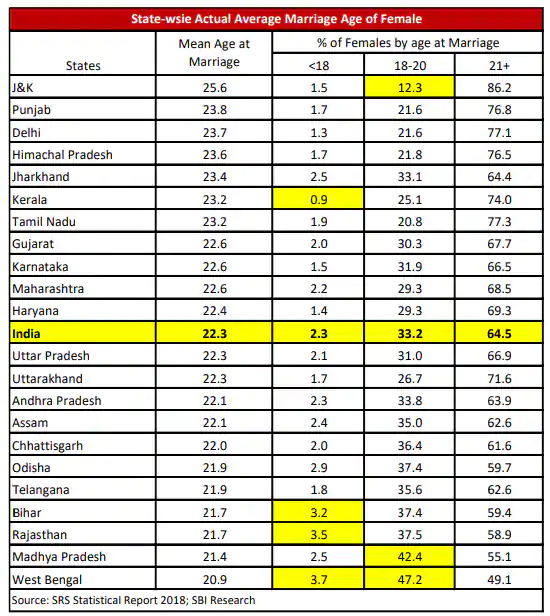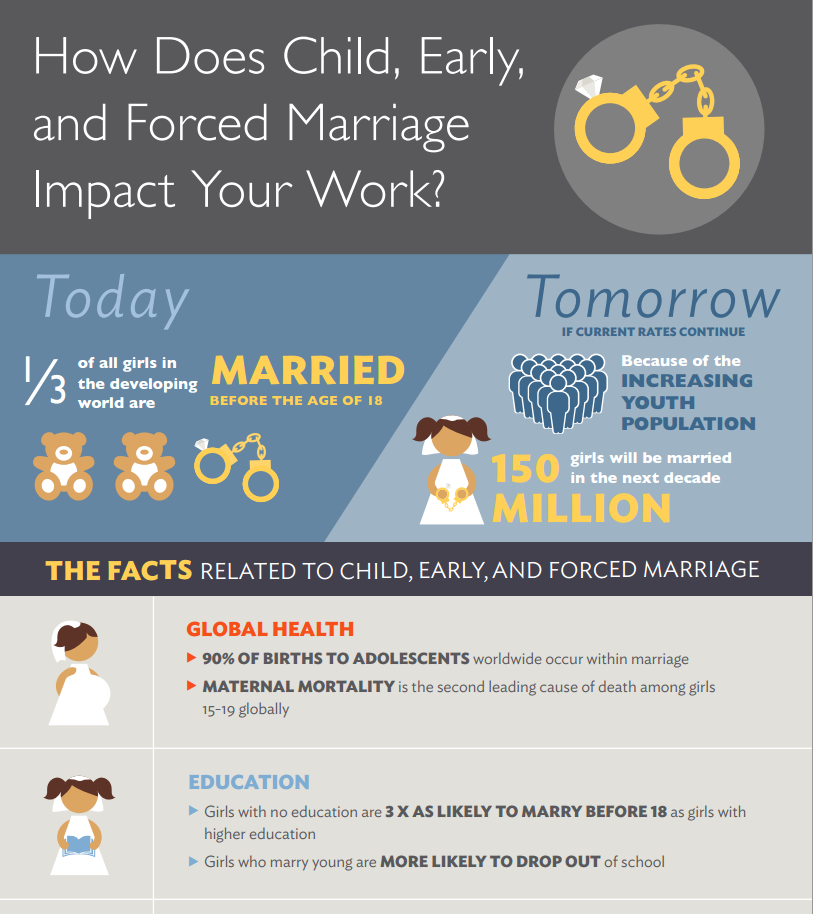Marriageable Age for Women | 23 Nov 2020
The government of India had announced that it is on the verge of increasing the legal age of marriage of women from 18 years.
- Several global organizations such as UNICEF have specified children under the age of 18 as minors and marriages below the specified age as child marriage.
Historical Background
- The United Nations adopted the Convention on Consent to Marriage, Minimum Age for Marriage and Registration for Marriages, which came into force in December 1964.
- It obligates States Parties to –
- Specify a minimum age for marriage
- Prohibit legal acceptance of any marriage without the full and free consent of both parties
- However, before the UN adopted this Convention, India had a law prescribing the minimum age of marriage, known as the Sarda Act, 1929 later renamed as the Child Marriage Restraint Act (CMRA), 1929.
- It was the first law created to prohibit child marriage which extended to the whole of India except Jammu and Kashmir.
- It prohibited the marriage of girls below the age of 15 years and boys below the age of 18.
- In 1978, the law was amended to raise the minimum age of marriage to 18 years for girls and 21 years for boys.
- This position remains the same even in the new law called the Prohibition of Child Marriages Act (PCMA), 2006, which replaced the CMRA.
- According to the law, if a marriage had occurred between a boy aged between 18-21 years and a girl below the age of 18 years, it implied an imprisonment up to 15 days along with a fine of one thousand rupees.
Present Scenario
- According to a recent report published by State Banking of India, 35% of females in India are married before the age of 21 years. The situation is grave in some states.
- In West Bengal, the mean marriage age is only 20.9 years and almost 47 per cent of females get married before the age of 21 years, even worse than Bihar and Rajasthan.
- Considering the data on maternal deaths, the maximum proportion of maternal deaths occur in the lower age bracket.
- Although India's maternal mortality ratio has improved to 113 in 2016-18 from 130 in 2014-2016, it is still far below the United Nations Sustainable Development Goals (SDGs) target of 70 deaths per 1,00,000 live births.
- The MMR of various States according to the latest bulletin includes Assam (215), Bihar (149), Madhya Pradesh (173), Chhattisgarh (159), Odisha (150), Rajasthan (164), Uttar Pradesh (197) and Uttarakhand (99).
- According to the Global Childhood Report released by UK-based NGO Save the Children, in India even today child marriage prevalence is higher in rural areas as compared to urban areas as these figures are 14.1% and 6.9% for rural and urban areas respectively for age group 15-19 years.
The Current Laws
- For Hindus, The Hindu Marriage Act, 1955, sets 18 years as the minimum age of marriage for the bride and 21 years as the minimum age for the groom.
- However, child marriages are not illegal even though they can be declared void at the request of the minor in the marriage.
- In Islam, the marriage of a minor who has attained puberty is considered valid.
- The Special Marriage Act, 1954 and the Prohibition of Child Marriage Act, 2006 also prescribe 18 and 21 years as the minimum age of consent for marriage for women and men respectively.
Prohibition of Child Marriage Act, 2006:
- The law seeks to prevent child marriages by making certain actions punishable and by appointing certain authorities responsible for the prevention and prohibition of child marriages.
- Child marriage is an offence punishable with rigorous imprisonment, which may extend to 2 years, or with fine up to Rs.1 Lakh, or both. The offences under the Act are cognisable and non-bailable.
- Persons who can be punished under the Law include
- Whoever performs, conducts or directs or abets any child marriage.
- A male adult above 18 years marrying a child (Section 9).
- Any person having charge of the child, including – parent or guardian, any member of an organisation or association, promoting, permitting, participating in a child marriage.
- A valuable provision in the PCMA is that it allows the minor party to repudiate the marriage or to have it nullified right up till two years of attaining majority.
Pros of Increasing Marriageable Age
- Socio-economic Fronts: Increasing the legal age for the marriage of women has enormous benefits on social and economic fronts including:
- Lowering the Maternal Mortality Ratio (MMR)
- Improvement of nutrition levels
- Financial front opportunities will be opened up for women to pursue higher education and careers and become financially empowered, thus resulting in a more egalitarian society.
- More female labour force participation: increasing the marriage age will push the mean marriage age higher and will lead to more females doing graduation and hence improving the female labour force participation ratio.
- The percentage of females doing graduation will increase by at least 5-7 percentage points from the current level of 9.8 per cent.
- The benefit for both: Both men and women will gain economically and socially by marrying when they are more than the legal age, but added that the urge of the women is much higher as they always get a higher payoff by becoming financially empowered to take decisions.
Cons of Increasing Marriageable Age
- Minimum is not mandatory: It is important that girls are not pushed into marriage early; marriage should not be compulsory for them to gain social and economic status. Yet, an increase in the minimum age of marriage to 21 years will be counterproductive.
- Minimum age of marriage does not mean mandatory age.
- It only signifies that below that age there could be criminal prosecution under the child marriage law.
- Rights of the girls are threatened: Increasing the age of marriage to 21 years would mean that girls will have no say in their personal matters until they are 21.
- The elementary right that the Convention of the Right of Children of UN bestows upon minors — the right to be heard, the right for their views to be considered — will be denied to girls right up till 21, beyond adulthood.
- Exploitation of law by parents: The law has been used by parents against eloping daughters. It has become a tool for parental control and for punishment of boys or men whom girls choose as their husbands.
- Most cases that are taken to court are self-arranged marriages. And only one-third of the cases relate to arranged marriages, which are sometimes brought by parents or husbands to dissolve or to nullify marriages that have broken down because of domestic violence, dowry or compatibility issues.
- Social validity of marriages: Even if the law declares a marriage before the specified age as void, in the eyes of the community, arranged marriages will have social validity.
- This worsens the condition of the girls who are widowed even before reaching the new legal age for marriage.
- Increased female infanticide: Moreover, raising the female marriage age in the countries that have high son preference and high poverty may have the unintended consequence of increasing the prevalence of female infanticide and sex-selective abortion.
Way forward
- Altering the thinking: Any ground-level change will only happen when the psyche of people will alter. No law is effective if change does not occur from within.
- Erasing the stereotype: Increasing the legal age for marriage is a must, even legally as it should get us out of the stereotype mindset that women are more mature than men of the same age and therefore can be allowed to marry sooner.
- Reconsidering the time limit for repudiation: As far as the issue of repudiation of marriage by girls is concerned, it should be changed from two to four years. Thus providing more time to rethink over the marriage.


